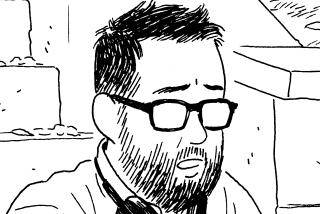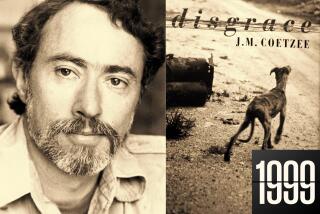Judith Vanistendael’s art of dying
Judith Vanistendael’s graphic novel “When David Lost His Voice” makes me uneasy -- and not just because its protagonist shares my first name. No, it’s more that in this exploration of one man’s death and its effect on his family, Vanistendael gets at the ways in which we are all connected ... and the ways that we are all alone.
At the center of the book is David, a fiftysomething bookseller who has been diagnosed with cancer of the larynx; he is literally losing his voice. Not that he’s ever been a great communicator, which is one of the key pillars of the narrative -- his reticence in the face of his mortality, which frustrates the three women in his life.
These women are his second wife, Paula, their 9-year-old daughter, Tamar, and his adult daughter, Miriam, who, as the book begins, gives birth to her own daughter, named Louise. There is a lot of passion here, but it is complicated, as real passions always are.
Early in the story, Miriam comes to visit her father in the bookstore only to watch as, before her eyes, he is transformed from living human to skeleton. It’s a metaphor, of course, a metaphor for what we all are, for what awaits us, but the power of the scene is heightened by the mundane nature of the dialogue, which revolved around a book David has set aside for her.
Vanistendael weaves this tension into the very heart of “When David Lost His Voice,” using minimal text and relying on her art to move the story. That’s a smart choice, not only because it’s thematically consistent but because the images are so strong. She draws in a rough-hewn, impressionistic style that is both fanciful and elemental at once. When, in the middle of the book, Tamar’s friend Max writes her a letter while she is off on a sailing trip with her father, he posts it by balloon; 20 pages later, it miraculously arrives.
This is not to suggest that “When David Lost His Voice” takes place in a magical universe -- the stakes here (love, death, loss, commitment) are nothing if not real. But that sailing trip is instructive, for even in the midst of death, there is life. David has no intention of giving up; the cancer may strip him of his vigor, but it does not take away his impulse to live.
In one of the book’s most moving sequences, Tamar visits him at the hospital after he has lost the ability to speak. “Stay with me,” she begs him, and so he writes her a note, assuring, “My darling, I am with you,” which she puts into a small bottle and wears as a talisman around her neck. It’s another vivid metaphor -- and yet, it’s also more than that, an expression of love and how it can sustain us, even (or especially) if it is incomplete.
As David fades, he litters his hospital room with more notes, expressing his love for Paula, and his desire to be released. Vanistendael highlights this by rendering him in increasingly elusive sketches, until he is little more than a blur in gray and white.
Everything -- color, definition, expression -- is stripped away, leaving only elemental forms. It is as if he is disappearing, a process that “When David Lost His Voice” explicates with no small measure of grace.
ALSO:
Revisiting David Wojnarowicz’s ‘7 Miles a Second’
Prefer not to? Kevin Smokler says you should reread ‘Bartleby’
More to Read
Sign up for our Book Club newsletter
Get the latest news, events and more from the Los Angeles Times Book Club, and help us get L.A. reading and talking.
You may occasionally receive promotional content from the Los Angeles Times.










